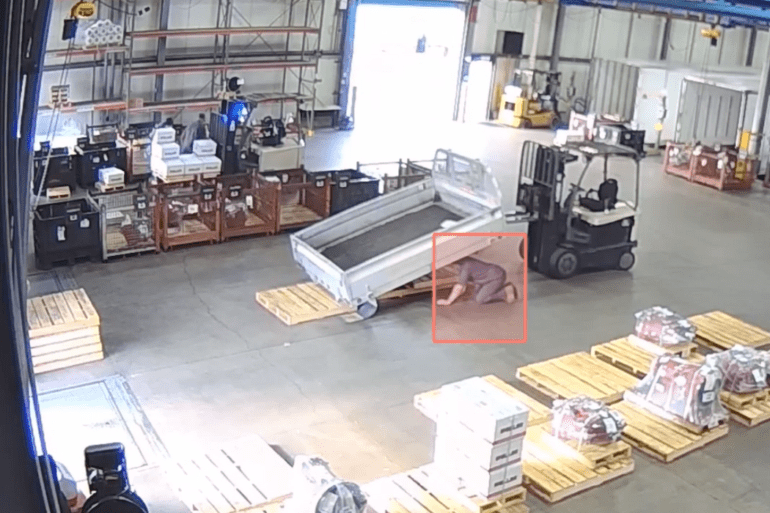TL;DR:
- Amazon’s EWR9 fulfillment center showcases AI-driven “goods-to-person” strategy.
- 45,000 self-driving pods replace traditional shelving, enhancing efficiency.
- AI orchestrates pod movements, ensuring safety and seamless interactions.
- Amazon’s lost-time injury rate drops by 69% from 2019 to 2022 with AI.
- AI surveillance aids injury prevention by analyzing extensive surveillance footage.
- CompScience’s AI identifies near misses, prompting proactive safety measures.
- Legal considerations emphasize transparency and data protection.
- Companies transition from observation to active response using AI insights.
- AI-powered safety systems are accessible to businesses of all sizes.
- Embracing AI fosters redefined workplace safety and risk management.
Main AI News:
In the dynamic landscape of modern industry, businesses are revolutionizing traditional work environments by harnessing the power of artificial intelligence (AI) to prioritize the well-being of their employees. This paradigm shift is vividly demonstrated at Amazon.com’s EWR9 fulfillment center, strategically located near the New Jersey Turnpike. At this massive 1.3-million-square-foot facility, a remarkable choreography unfolds – a synchronized dance between humans and AI-driven automation.
Within this bustling hub, approximately 45,000 pods, characterized by their distinct four-sided shelving units, elegantly glide across the floor on self-driving units. The days of workers traversing vast distances to access shelves are long gone; now, the shelves come to the workers. This innovative “goods-to-person” approach, propelled by a fusion of artificial intelligence and sensor technologies, epitomizes Amazon’s commitment to efficiency, ergonomic design, and, most importantly, safety.
The balletic performance of these self-driving units is orchestrated by an unseen conductor – an AI system residing in the cloud. This digital overseer orchestrates the graceful movements of the pods, ensuring seamless interactions between human workers and their robotic counterparts. Such synergy cultivates an environment where safety prevails, leaving human workers to focus on their specialized tasks. Even Amazon’s top managerial figures are not exempt from these safety measures; only designated specialists equipped with specialized vests that create an electromagnetic buffer zone are allowed to venture into the pod-populated territory.
The resounding success of this paradigm has borne fruit in tangible metrics. Amazon’s embrace of AI-powered robotics has yielded a remarkable 69% reduction in lost-time injuries from 2019 to 2022. The pivotal role of AI is evident in the contrast between sites employing this technology and those that do not – the latter witnessing a concerning 21% increase in lost-time injury rates.
While the concept of AI surveillance may raise concerns among workers, the benefits are undeniable. Proponents contend that this technology is poised to prevent debilitating injuries, safeguarding both employees and employers from the physical and financial ramifications of workplace accidents. The Bureau of Labor Statistics revealed that over 2.2 million workers suffered job-related injuries in 2021, resulting in 5,190 fatalities – a troubling 9% surge from the prior year.
Enter AI-driven innovations like those offered by CompScience, which seamlessly integrate with existing surveillance systems. By meticulously analyzing voluminous hours of footage, these AI systems identify potential safety hazards and near-miss scenarios. Companies like Propak have harnessed CompScience’s capabilities to uncover hidden risks, leading to proactive interventions that enhance workplace safety.
As the business landscape evolves, so do the ethical and legal considerations surrounding AI-driven surveillance. Domenique Camacho Moran, a seasoned expert in employment law, underscores the importance of transparency and compliance. Companies must tread carefully, ensuring that personal health data is not inadvertently collected. Employees should be informed of data collection practices and the potential involvement of AI systems. Furthermore, businesses must transition from passive observation to active response, acting swiftly upon AI-generated insights.
While Amazon stands as a trailblazing advocate for safety initiatives, the realm of AI-powered safety systems is no longer confined to corporate giants. Emerging technologies empower businesses across scales to prioritize their workforce’s well-being, bolstered by the knowledge that AI can proactively mitigate risks and curb the staggering costs of workplace injuries.
In the face of skepticism, it is crucial to recognize that AI-driven innovations are not intended to usurp human agency, but rather to fortify it. By embracing these advancements, companies embark on a journey to redefine workplace safety, reconfigure risk management, and ultimately reshape the very fabric of modern industry. As Josh Butler, founder and CEO of CompScience, aptly puts it, “Workplace safety is a huge problem. We’re really looking at ways to change the systemic level of risk.” Through the harmonious integration of human expertise and AI capabilities, this systemic transformation is within reach, paving the way to a safer and more productive future.
Conclusion:
The integration of AI in redefining workplace safety, as exemplified by Amazon and CompScience, signifies a transformative shift in the market. By harnessing AI’s potential to prevent injuries, enhance surveillance, and improve risk management, businesses of all scales have an opportunity to reshape workplace safety norms. This proactive approach not only safeguards employees but also streamlines operations and reduces the financial burden of workplace accidents, thereby fostering a more sustainable and efficient future for the market.

